I’m sure you’ve heard of Memrise by now.
Maybe a polyglot YouTuber mentioned it was a central part of their language learning routine.
Or a fellow language learner might have recommended it to you.
But what is Memrise, how does it teach foreign languages?
Well, with science. I’ll explain.
The Science of Memrise: Spaced Repetition System Flashcards at Work
Like the name suggests, I discovered that Memrise helps you to “memorize” things using proven brain science. While there are technically Memrise courses for multiple subject areas, its use of brain science is most useful for language learning—and it seems like this is what the app is mainly known for.
In fact, Memrise has hundreds if not thousands of foreign language courses.
These courses are what the program calls “decks.” While I was exploring the program, I noticed that each deck comes with a preset number of words and phrases in the chosen language, which are divided up into lessons.
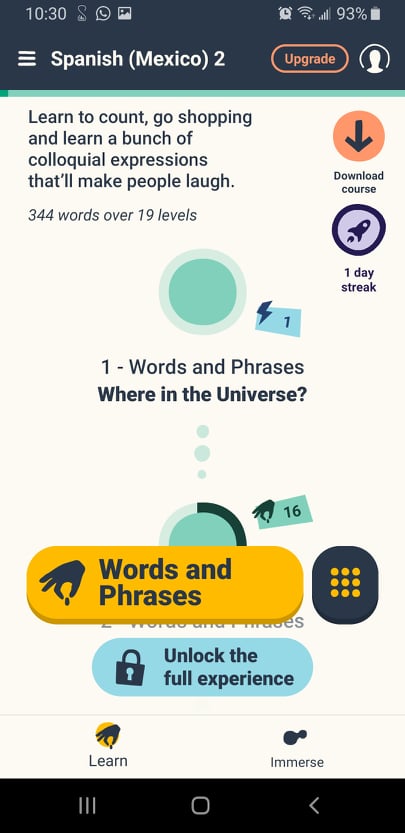
The learning process is simple: each word or phrase has its own flashcard, and I could master each flashcard through a series of repetitions.
Each repetition grew my knowledge of the word, and this is represented by the growth stages of a flower.
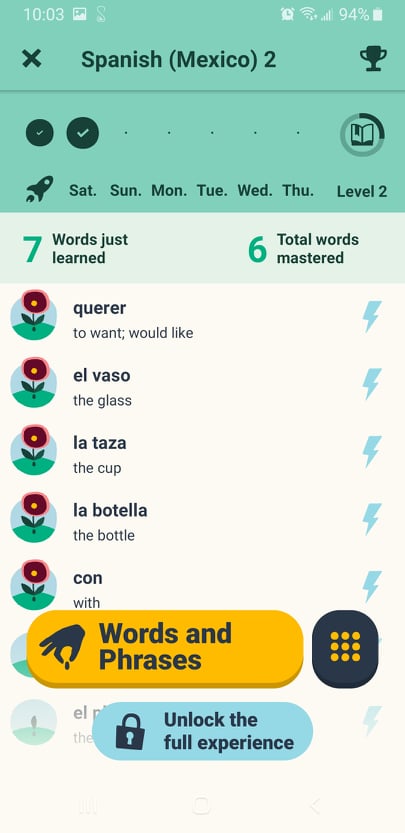
I didn’t just review these words and phrases randomly, however; this is where the brain science comes in.
Memrise uses a review algorithm called a Spaced Repetition System (SRS). This means that Memrise kept track of the flashcards I had trouble remembering, and it prompted me to review them more often than those I could recall easily.
Furthermore, Memrise uses spaced repetition to review these flashcards at critical intervals to ensure the words transfer from the short-term memory to long-term memory. Long-term memory is what allows us to use what we learn in real conversations with native speakers or while reading or listening to the language.
Don’t take my word for the effectiveness of spaced repetition, though. There have been hundreds of studies that show spaced repetition is an efficient way to learn new words in a language. For example, one study found that, with just 3 minutes a day of SRS practice, EFL students retained vocabulary 3 times as well long term.
Memrise’s Main Features
Now that we understand how spaced repetition works and how it’s a highly effective way to learn a language, let’s look at how Memrise puts this to work.
Unlimited Learning Capacities
Aside from spaced repetition, Memrise’s secret power is that it hosts two types of courses: decks created by the company itself as well as decks created by users.
As expected, Memrise hosts and focuses its efforts on creating and promoting company-created courses. I found that these decks are highly professional with videos, native audio and accurate translations between the target language and native language.
These company-created courses also span multiple levels. For some languages, this means that you can learn across many levels, often starting at the beginner stage and leading toward advanced. For example, I explored the Spanish courses, and there were 7 levels, each with dozens of decks.
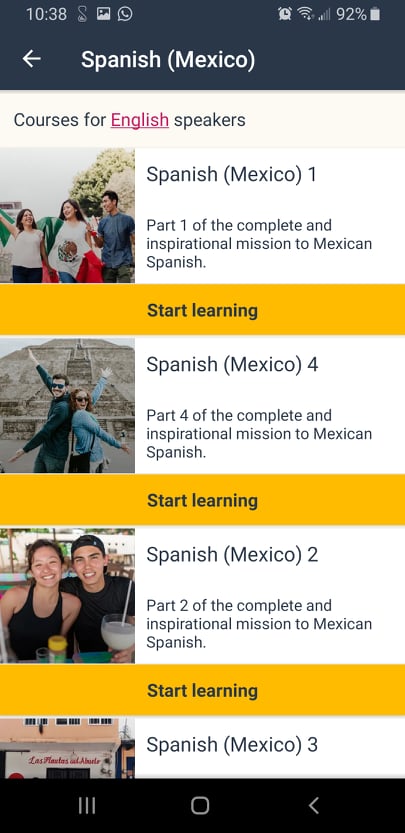
With these courses, I could master thousands of words in a given language, starting with the most useful and then growing in complexity.
But there are also user-created courses.
Primarily, these are decks curated by fellow learners or native speakers of a given language. On Memrise, there are far more languages and levels covered through user-created courses than by the company-created ones.
As if that wasn’t enough, there’s technically also a third type of course. It’s the one that you—or I—create!
In fact, we a language learners can also create our own decks to be used in the Memrise interface. This would allow me to master words and phrases that are most useful to my language learning journey and have complete control over my studying. For example, I could use Memrise alongside my favorite French podcast, and create custom flashcards based on new vocabulary I heard in the episodes.
Because of these three options—company-created courses, user-created courses and personally-created courses—the amount you can learn on Memrise is virtually limitless. You can legitimately learn thousands of words!
How Many Languages Does Memrise Offer?
The answer to how many languages you can study on Memrise is a tricky yet satisfying one.
Officially, I found that it’s possible to study 23 languages on Memrise. These are “official” courses because they are the company-created decks we talked about earlier in the post. These courses tend to teach the most commonly studied languages, and they offer high quality decks complete with native audio, vetted flashcards and even videos.
These languages include Mexican Spanish, European Spanish, French, German, Japanese, Italian, Korean, Chinese , Brazilian Portuguese, European Portuguese, Russian, Arabic, Dutch, Swedish, Norwegian, Polish, Turkish, Danish, English, Yoruba, Icelandic, Mongolian and Slovenian.
Unofficially, however, the number of languages offered by Memrise is unlimited. This is because of Memrise’s community-created decks potential. In short, if I were to create a deck, it can become public, meaning that other users can study the deck to learn that language.
That means there are decks for languages like Cree, Afrikaans, Navajo and Swahili. There are many others available, and the repertoire—as well as quality—of these community-created decks are always increasing. Maybe you’ll even create a custom deck for a language you want to study!
Authentic Native Material
Native content is crucial to speaking and understanding a language as it’s actually spoken, so Memrise makes sure to include loads of authentic material to its flashcard decks.
In fact, all company-created courses include native audio and video in the target language. During my trial of the company-created deck in Spanish, there were actually videos and audio clips in native Spanish speech to help me master the flashcards in the course.
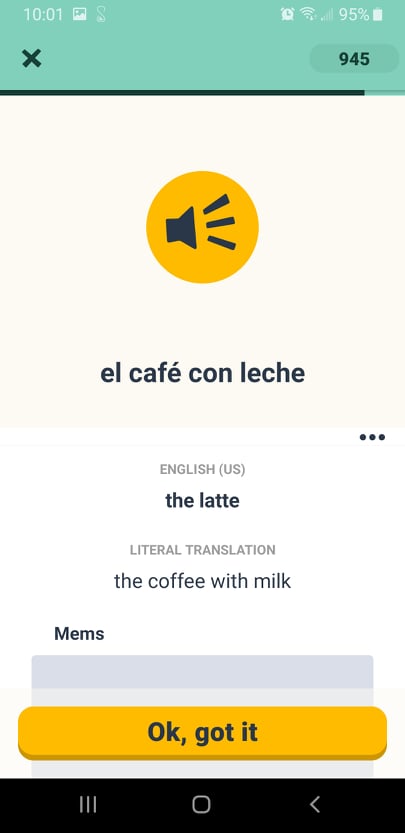
The audio clips are part of what is called “Pronunciation Mode.” This feature is available after having learned at least three cards in a deck. In short, the audio is played at a regular speed, but there is also the option of listening to it at 0.5 speed. Pressing the microphone allows for the learner to record their own audio, and then the pronunciation is automatically graded by Memrise.
While this is a staple in company-created courses, I discovered that many user-created decks also have recorded audio, and there’s an option to record audio if I wanted to make a deck of my own.
Furthermore, many different accents are represented in both company-created and user-created courses.
For example, a language like Spanish has various dialects and differences depending on where it’s spoken. With Memrise, you can study a deck that focuses on the dialect or accent you choose. In fact, Memrise hosts both Mexican Spanish and Spanish from Spain courses, and you can find user-created courses in Argentinian Spanish and Chilean Spanish, just to name a few.
General & Specialized Content
In addition to general language courses that aim to teach based on a level, I also found courses based on different topics.
That means I could choose to specialize my learning, whether I wanted to master words related to business, science or even literature. For example, I could take a Business Dutch or Medical German course.
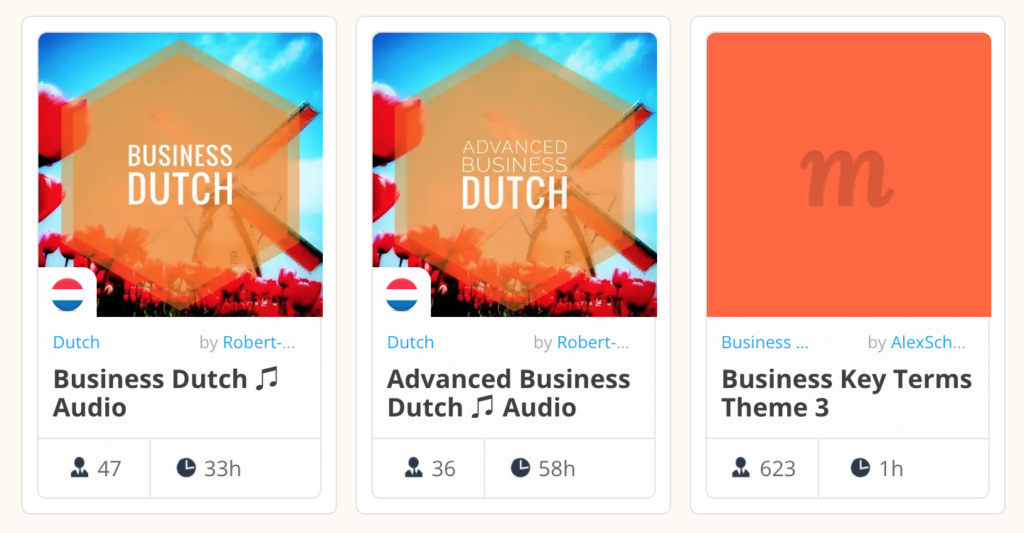
There are even courses that focus on frequency lists.
A frequency list is a collection of vocabulary words that are sorted based on how often the word is used in a language. These types of decks focus on the most common words in a language so you can watch your comprehension soar fast.
I also found it fantastic that users can also cross-pollenate and use Memrise to enhance other courses or language learning apps. This is most commonly done through custom decks.
These have been created to accompany other language learning materials such as textbooks or other programs like Duolingo. For example, I found a Russian deck that exclusively reviews vocabulary learned in the Russian Duolingo course.
Language Learning Support Features
Memrise isn’t just a straightforward spaced repetition flashcard app. There are a number of support features to maximize the learning experience.
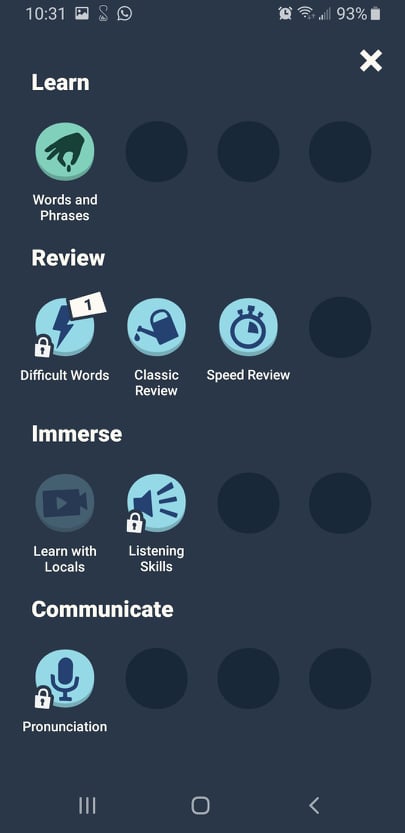
Memrise’s “Learn New Words” feature is the starting point for most vocabulary.
Here, new words are presented in written and audio form (as well as native videos in official Memrise courses) and I was “growing” my knowledge of them through repetition. This repetition includes various translation activities from the target language to the native language and vice versa.
The “Review” feature is where spaced repetition plays a big role in learning. The spaced repetition algorithm determines which words need review and when, and revisiting these words keeps them fresh in your mind and accessible for real usage.
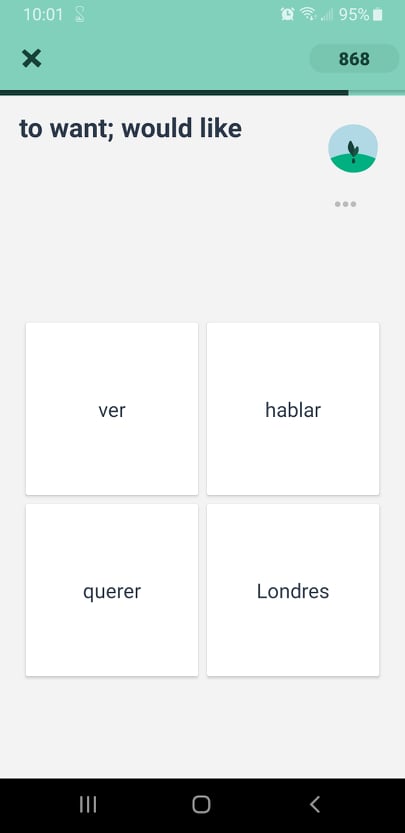
“Speed Review” is exactly what it sounds like: a timed practice of words that need to be reviewed. I found this particularly useful with words I thought I knew well. This review really put my knowledge to the test!
There are also two other types of reviews. These are the “Audio Review” and “Difficult Words” review. The “Audio Review” features only audio flashcards, and the “Difficult Words” reviews focus on those you have trouble recalling. These two are only available to paying subscribers.
Memrise also has a “Learn Grammar” feature on some of the most studied courses. These tutorials are quite short. Rather than an in-depth explanation of a grammar rule, they show patterns within the language in an attempt to explain a grammatical concept. After being shown the pattern, there are a couple practice exercises. As of October 2021, this feature is only available for UK English learners who use the iOS and Android versions of certain courses.
Some decks include the “Learn with Locals” features. These are only available in company-created courses, and these are short videos in the target language where I had to transcribe what was being said. I thought this was a great way to hear the language as it is actually spoken.
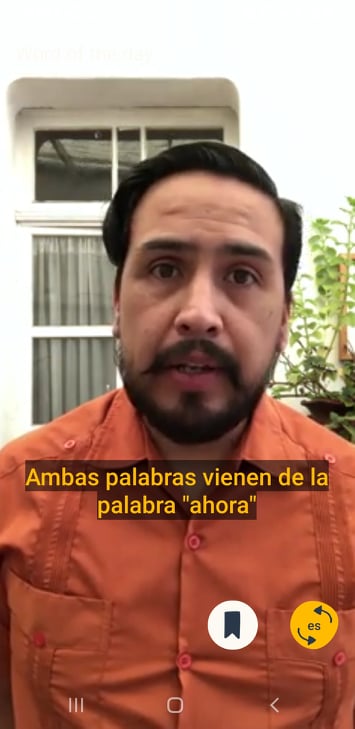
Lastly, I noticed that Memrise includes a pretty cool feature called “Explore Mode.” In short, “Explore Mode” in a picture recognition capability. Simply point your smartphone’s camera at an object and get the name of that object in your target language. This feature is only available to Apple product users, however, and is not available for Android or on the Memrise website.
Subscription Plans
I mentioned “paying subscribers” earlier, so let’s examine what Memrise offers for its learners at all price points.
The good news is that Memrise is mostly free.
Its core program—including both company-created and user-created courses—can be accessed on its website or in-app without cost.
In fact, most of the program’s basic and most useful features like “Learn New Words,” “Review” and “Speed Review” are available to all users who sign up for a free account. In my opinion, there are enough free features for a fruitful language learning experience, but more on that later.
For those looking for more, a premium membership to Memrise Pro includes additional features such as the “Audio Review” and “Difficult Words” review function, learning statistics, grammar bots, chatbots and what the programs describes as a “full range of official Memrise courses.”
This last part is a little confusing since it seems to me that most, if not all, official Memrise courses seem to be free though.
The premium membership also gives learners access to “immerse” features such as “Listening Skills.” This tests learners on audio clips of the words and phrases they’ve learned. Simply listen to the clip and tap the correct written answer.
I also found out that there is an “Offline Mode” for paying subscribers that lets them download decks to their smartphones for offline use.
As of September 2021, a premium plan costs $8.99 a month. You can get it for $5.00 a month when you purchase an annual plan, and a lifetime membership costs $139.99. But of course, be mindful that prices are always subject to change.
Memrise in Practice: Can You Learn a Language with Memrise?
Now that we’ve had an overview of Memrise’s theoretical background as well as its features, let’s take a look at the question on everyone’s mind: can Memrise actually teach you a language?
Memrise’s Pros
As we explored in the first section of this review, the science behind the Memrise program is solid.
We know that spaced repetition is proven to maximize brain power, helping you learn new words in a language, and Memrise does spaced repetition in an orderly and seamless fashion. In fact, its interface is so sleek, it’s easy to forget that you’re simply working with flashcards.
Better yet, Memrise’s flashcards aren’t just words and phrases. Real native content is great for improving your accent and tuning your ear to the language, and Memrise does this well with high quality audio and video in its company-created courses.
There are also positives in Memrise’s customizable learning regimen. I love how the lessons themselves sort new words and phrases into manageable chunks for learners, normally focusing on 20 to 30 words per lesson in a deck.
You can also learn as much or as little as you want with Memrise and even set your own goals for how long you want to spend on the app.
Other positives include the sheer amount of variety offered in the program. Memrise allows you to learn at any level of proficiency and in any register of the language, whether in a business, academic or informal setting.
New courses are being added regularly by both the company itself and its users, so the possibilities are endless. It really is a polyglot’s dream in that respect.
An added bonus is the ability to create your own decks that you can study through Memrise’s interface. Since you can create your own flashcards, Memrise can be a highly useful platform for independent learners self-studying a language.
Memrise’s Cons
While there are many highlights, Memrise isn’t without its limitations or shortcomings.
In fact, Memrise’s biggest limitation is something that comes inherent with flashcards and may be out of the company’s control: Memrise is great for learning individual words and phrases via flashcards, but these are always in isolation.
By nature, flashcards lack context, often presenting words or phrases by themselves. This can create a sort of “word salad” for you, leading to problems in seamless communication or understanding.
In fact, I found this particularly tricky with words that have multiple meanings.
If you’ve learned a word to have a single meaning, seeing it used in a different way to convey another meaning may lead to breakdowns in the conversation as well as confusion.
Another thing I noticed about Memrise is that there are no explicit explanations or tutorials for US English users. Even for UK English users, these grammar explanations seem rather limited, and could prove useless for intermediate and advanced learners.
In fact, in-depth grammar, pronunciation tips and language usage notes are almost non-existent in the program. While this may not be an issue for those simply looking for a flashcard app, this makes it almost impossible for you to learn a language with Memrise alone.
Furthermore, there aren’t any opportunities for meaningful written or spoken production. While there are the “Pronunciation Mode” and “Listening Skills” features, these focus on recall, not real language usage.
Other than typing in a word or its translation, there’s no opportunity for spontaneous language usage. This is crucial for learning a language, and without the opportunity to create longer written or spoken sentences, you’ll lack critical practice using Memrise alone.
Outside of company-created courses, there could also, in theory, be errors in Memrise’s user-generated decks and flashcards.
The number of user-created decks would make it impossible for Memrise to vet them all, and while there’s a webform for learners to report an error in a flashcard, such issues could go unnoticed by beginners.
Is Memrise Worth It?
All things considered, Memrise is a useful language learning program and app, but it shouldn’t be the end-all and be-all for language learners.
It’s undeniable that Memrise harnesses spaced repetition technology to help you master new words and phrases and keep them in your long-term memory.
It’s also a monster directory for vocabulary in many languages, and you could learn a lot from both its company-created and user-created courses. Not to mention, Memrise gives learners unprecedented control over their learning, and Memrise is a great place to create your own flashcards.
However, Memrise can’t be a well-rounded course based on flashcards alone. Flashcards inherently lack context, and Memrise has no real opportunities for immersion.
Meaningful reading, writing, speaking and listening practice is absent, and there are no tutorials to guide you through grammar and language usage. As such, you can’t bank on Memrise to teach you a language in its entirety.
I also noticed that there doesn’t seem to be much of a difference between the free version of Memrise and the paid version. The free version of the app is more than enough for language learners, and there aren’t many apparent benefits for paying members.
Does that make Memrise useless? Of course not!
In summary, I recommend Memrise as a vocabulary building app for all levels of language learners. However, even with recent additions to the program, I do not believe it is worth paying for the premium features for the average user.
Like many apps and language learning programs, Memrise can be a part of a successful language learning regimen. Knowing that Memrise teaches new words and phrases really well, you could match it with an online course, a textbook or even an immersion environment to maximize vocabulary growth.



0 Comments